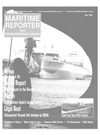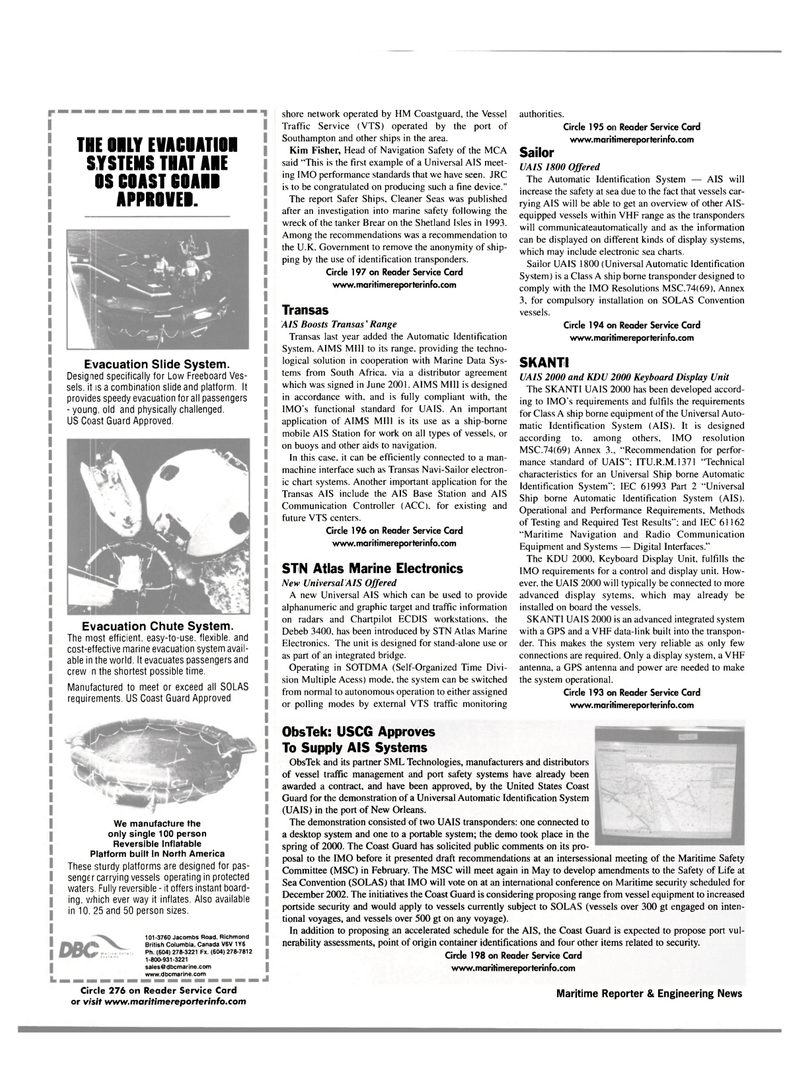
Page 22: of Maritime Reporter Magazine (May 2002)
Read this page in Pdf, Flash or Html5 edition of May 2002 Maritime Reporter Magazine
THE ONLY EVACUATION
SYSTEMS THAT ANE
OS COAST GOAND
APPROVED.
Evacuation Slide System.
Designed specifically for Low Freeboard Ves- sels, it is a combination slide and platform. It provides speedy evacuation for all passengers - young, old and physically challenged.
US Coast Guard Approved.
Evacuation Chute System.
The most efficient, easy-to-use, flexible, and cost-effective marine evacuation system avail- able in the world. It evacuates passengers and crew n the shortest possible time.
Manufactured to meet or exceed all SOLAS requirements. US Coast Guard Approved
We manufacture the only single 100 person
Reversible Inflatable
Platform built in North America
These sturdy platforms are designed for pas- senger carrying vessels operating in protected waters. Fully reversible - it offers instant board- ing, which ever way it inflates. Also available in 10, 25 and 50 person sizes. 101-3760 Jacombs Road. Richmond
British Columbia, Canada V6V 1Y6
Ph. (604) 278-3221 Fx. (604) 278-7812 1-800-931-3221 [email protected] www.dbcmarine.com shore network operated by HM Coastguard, the Vessel
Traffic Service (VTS) operated by the port of
Southampton and other ships in the area.
Kim Fisher, Head of Navigation Safety of the MCA said "This is the first example of a Universal AIS meet- ing IMO performance standards that we have seen. JRC is to be congratulated on producing such a fine device."
The report Safer Ships, Cleaner Seas was published after an investigation into marine safety following the wreck of the tanker Brear on the Shetland Isles in 1993.
Among the recommendations was a recommendation to the U.K. Government to remove the anonymity of ship- ping by the use of identification transponders.
Circle 197 on Reader Service Card www.maritimereporterinfo.com
Transas
AIS Boosts Transas' Range
Transas last year added the Automatic Identification
System. AIMS Mill to its range, providing the techno- logical solution in cooperation with Marine Data Sys- tems from South Africa, via a distributor agreement which was signed in June 2001. AIMS Mill is designed in accordance with, and is fully compliant with, the
IMO's functional standard for UAIS. An important application of AIMS Mill is its use as a ship-borne mobile AIS Station for work on all types of vessels, or on buoys and other aids to navigation.
In this case, it can be efficiently connected to a man- machine interface such as Transas Navi-Sailor electron- ic chart systems. Another important application for the
Transas AIS include the AIS Base Station and AIS
Communication Controller (ACC). for existing and future VTS centers.
Circle 196 on Reader Service Card www.maritimereporterinfo.com
STN Atlas Marine Electronics
New Universal AIS Offered
A new Universal AIS which can be used to provide alphanumeric and graphic target and traffic information on radars and Chartpilot ECDIS workstations, the
Debeb 3400, has been introduced by STN Atlas Marine
Electronics. The unit is designed for stand-alone use or as part of an integrated bridge.
Operating in SOTDMA (Self-Organized Time Divi- sion Multiple Acess) mode, the system can be switched from normal to autonomous operation to either assigned or polling modes by external VTS traffic monitoring authorities.
Circle 195 on Reader Service Card www.maritimereporterinfo.com
Sailor
UAIS 1800 Offered
The Automatic Identification System — AIS will increase the safety at sea due to the fact that vessels car- rying AIS will be able to get an overview of other AIS- equipped vessels within VHF range as the transponders will communicateautomatically and as the information can be displayed on different kinds of display systems, which may include electronic sea charts.
Sailor UAIS 1800 (Universal Automatic Identification
System) is a Class A ship borne transponder designed to comply with the IMO Resolutions MSC.74(69), Annex 3, for compulsory installation on SOLAS Convention vessels.
Circle 194 on Reader Service Card www.maritimereporterinfo.com
SKANTI
UAIS 2000 and KDU 2000 Keyboard Display Unit
The SKANTI UAIS 2000 has been developed accord- ing to IMO's requirements and fulfils the requirements for Class A ship borne equipment of the Universal Auto- matic Identification System (AIS). It is designed according to. among others, IMO resolution
MSC.74(69) Annex 3., "Recommendation for perfor- mance standard of UAIS"; ITU.R.M.1371 "Technical characteristics for an Universal Ship borne Automatic
Identification System"; IEC 61993 Part 2 "Universal
Ship borne Automatic Identification System (AIS).
Operational and Performance Requirements, Methods of Testing and Required Test Results"; and IEC 61162 "Maritime Navigation and Radio Communication
Equipment and Systems — Digital Interfaces."
The KDU 2000, Keyboard Display Unit, fulfills the
IMO requirements for a control and display unit. How- ever, the UAIS 2000 will typically be connected to more advanced display sytems, which may already be installed on board the vessels.
SKANTI UAIS 2000 is an advanced integrated system with a GPS and a VHF data-link built into the transpon- der. This makes the system very reliable as only few connections are required. Only a display system, a VHF antenna, a GPS antenna and power are needed to make the system operational.
Circle 193 on Reader Service Card www.maritimereporterinfo.com
ObsTek: USCG Approves
To Supply AIS Systems
ObsTek and its partner SML Technologies, manufacturers and distributors of vessel traffic management and port safety systems have already been awarded a contract, and have been approved, by the United States Coast
Guard for the demonstration of a Universal Automatic Identification System (UAIS) in the port of New Orleans.
The demonstration consisted of two UAIS transponders: one connected to a desktop system and one to a portable system; the demo took place in the spring of 2000. The Coast Guard has solicited public comments on its pro- posal to the IMO before it presented draft recommendations at an intersessional meeting of the Maritime Safety
Committee (MSC) in February. The MSC will meet again in May to develop amendments to the Safety of Life at
Sea Convention (SOLAS) that IMO will vote on at an international conference on Maritime security scheduled for
December 2002. The initiatives the Coast Guard is considering proposing range from vessel equipment to increased portside security and would apply to vessels currently subject to SOLAS (vessels over 300 gt engaged on inten- tional voyages, and vessels over 500 gt on any voyage).
In addition to proposing an accelerated schedule for the AIS, the Coast Guard is expected to propose port vul- nerability assessments, point of origin container identifications and four other items related to security.
Circle 198 on Reader Service Card www.mariHmereporterinfo.com
Circle 276 on Reader Service Card or visit www.maritimereporterinfo.com Maritime Reporter & Engineering News

 21
21

 23
23
